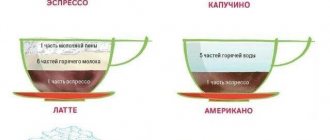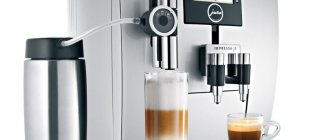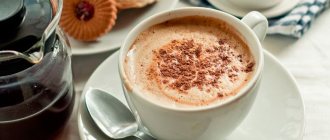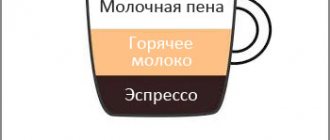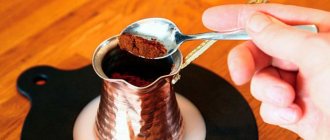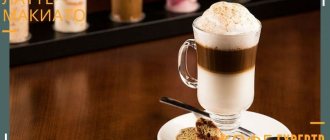In this article we will figure out how to correctly pronounce the phrase coffee latte. Because many people don't know the correct accent. Both the spelling and pronunciation of latte have certain rules.
This is a borrowed word from the Italians. And latte literally translates from Italian as milk.
In Italy, after the emergence of coffee culture in the country, names such as:
- cappuccino;
- latte;
- espresso, etc.
Many people still remember the time when they spoke coffee with milk - café latte. Italians take everything literally. And if you order them a latte, they will bring you milk. It doesn’t matter in what form: warm, whipped. But it will be milk.
And to order coffee with milk, you must not forget about the phrase cafe latte. With us everything is completely different. Every barista understands what the guest wants when they say the word latte.
Which syllable is stressed in the word latte?
Not long ago we heard the opinion that the emphasis in the word “latte” should be placed on the last syllable. Let's figure out where the word came from and which vowel will be stressed?
“Latte” is a word borrowed from Italian and translated as “milk.” The name of the drink “coffee latte” literally means “coffee with milk”.
A little history
Today it is impossible to name the discoverer of the recipe. The authorship is disputed by the French, Italians and Austrians. If we turn to historical sources, there are recorded references to making coffee with milk in the stories of travelers about the Austro-Hungarian Empire, as well as in essays about Venice, Holland and other European countries.
Italians have their own version of the origin of the drink.
Once upon a time there was a certain bartender or even a barista, and he served visitors to his establishment, among other drinks, the most common milk - “latte” in Italian. But one day he wanted to improve the taste of a familiar product, and he added a little coffee to the milk. Not only he, but also the guests of the establishment liked the drink. They didn’t come up with a name for it, they left everything as it is – latte coffee. In Russian translation - coffee with milk.
No matter who came up with the recipe, it was the Italian name that stuck in European barista practice. There is nothing surprising about this - many terms in the modern coffee business are of Italian origin. And since the word is Italian, they pronounce it in the Italian manner, with emphasis on the first syllable.
Of course, most European languages have their own equivalent recipe names.
- In French: cafe au lait. The French version is pronounced without a final consonant and sounds like one long syllable “le”.
- In Spanish they say: café con leche. The phonetics of the Spanish word resembles the Italian version and sounds with the same stress on the first syllable.
Here we could recall the common Indo-European linguistic roots, but it seems that we have gone too far in our small study.
Let's return to the modern latte. We found out that the word is Italian and is pronounced with emphasis on the first syllable. But let's see how foreign language borrowing behaves in our native Russian language. Perhaps the emphasis changes in the Russian version?
Rules for making latte
To serve a cocktail effectively and beautifully, you must adhere to the following rules:
- Lattes should be served in tall, clear glasses. This is necessary so that the layers of milk, coffee and foam are clearly visible;
- For the drink, it is better to take natural fat milk and whip it with a special steam pipe (cappuccino maker) in a special metal jug (pitcher);
- First, you need to pour hot milk with foam into a glass. Only then should you very carefully pour in the hot espresso;
- As an addition to the drink, you can take any syrup and pour it into the latte in a thin stream. It should settle to the bottom of the drink;
- Milk foam can be decorated with grated vanilla, cocoa powder, chocolate chips or a beautiful homemade design;
- The latte is served with a straw and brown square sugar.
What is the correct stress in the word “latte” for the Russian language?
In Russian coffee shops and in everyday life, we hear the name of the Italian recipe in different pronunciations. Sometimes this leads to heated arguments. Let's approach the issue from the perspective of language rules.
The word is new to the Russian language, having come into use quite recently.
By the way, “coffee” is also considered a relative newcomer to the Russian language, although we have been using this name for about 300 years, and it has long been part of the active vocabulary.
New borrowed words in Russian are used according to the scheme of the source language. This happens until the influence of our native speech changes the borrowing according to the rules adopted in the Russian language. But this does not happen immediately and not soon. Therefore, the term “latte” is used according to the rules of the Italian language, with the emphasis on the first syllable.
Foggy future
If this word lives in our linguistic space long enough, it will change its pronunciation. It can be assumed that in the future the double consonant will disappear, and the hard pronunciation of “t” will change to soft, as often happens in our language. It is quite possible that the stress will move to the last syllable, but these processes will take more than a dozen years. Until then, the phonetics of the source language is preserved, along with stress and pronunciation features.
“Coffee” and “latte” - what kind?
When you have sorted out the spelling, it would be useful to find out other nuances that relate to the words “coffee”, “glaze”, “latte”. The question of how to correctly use the word “coffee” in a sentence sometimes worries those who are trying to speak competently and correctly. And for good reason.
After all, words of foreign origin are indeclinable and the letter “e” at the end always confuses. How to correctly determine the gender in such names as “glace”, “coffee”, “latte”. All indeclinable nouns that end in "e" are neuter. But is it the same with the word “coffee”?
But when "coffee" appears in literary works, it is mostly masculine. Why? There is a detailed explanation. Initially, this invigorating drink was known in Russia under the name “coffee or coffee”.
Many years passed until the familiar name “coffee” was established in society, and “coffee” sank into oblivion. Therefore, this name of the drink is masculine. But despite these rules, you can find many examples in the literature with such a phrase as “black coffee”. And this does not mean that the people who used it are unfamiliar with the rules of the Russian language.
To avoid any questions, the Ministry of Education accepted the changes and allowed the use of the noun “coffee” in the neuter and masculine gender.
Let's turn to the authorities
Until recently, the word “latte” did not have a dictionary fixation in the Russian language. That is, it was not included in any dictionary. This is a typical phenomenon for neologisms or recent borrowings.
But a few years ago the name of the drink received official status. The word “latte” was included in the 2012 edition of the “Russian Spelling Dictionary”. This is an authoritative academic publication edited by the famous Russian philologist V.V. Lopatina. The dictionary was published by the Russian Language Institute of the Russian Academy of Sciences and deserves every confidence.
In this edition, the word “latte” is designated as a lexeme with stress on the first syllable. As for the remaining grammatical features, the word has a masculine gender and an unchangeable form, that is, it does not decline cases and has no numerical forms.
According to the rules, you can't say
- "my latte"
- “The lattes are hot.”
Only in the masculine gender:
- "my latte"
- "The latte is hot."
For those who just can’t remember what emphasis should be placed in the name “latte,” we offer a humorous mnemonic formula for better memorization: “Take your paws off the latte!” or “Coffee Latte does not wear armor”
Difficulties with foreign words
There are many interesting recipes, each of which has its fans. For example, delicious and sweet iced coffee. There are usually no difficulties in pronouncing this word, but you can often see a spelling mistake. The name of this recipe is correctly written with one letter “c”, as it comes from the French “glace”, which translates to “frozen” or “ice”. The following words also deserve special attention:
- barista;
- cappuccino;
- tiramisu;
- Americano;
- espresso.
You might be interested in The best instant coffee according to the Test Purchase
Coffee sommelier and specialist in preparing various types of coffee - barista. This word cannot be declined; it is always masculine. Therefore, it is correct to say: “She is an excellent barista.”
The name of the much-loved coffee recipe “Americano” does not yet have a fixed rule, but linguists are inclined to believe that it is a masculine word.
It is often difficult to spell the name “cappuccino”. In the menus of restaurants and cafes you can often see common errors, or rather double consonants “p” or “ch”. It is necessary to remember that the spelling “cappuccino” is the only correct one.
What do you need to know about the accent in the word "latte"?
- This is a borrowed language unit of Italian origin.
- In the source language it is pronounced with emphasis on the first syllable.
- In the Russian language it has a dictionary fixation in the “Russian Spelling Dictionary”.
- In Russian, it is used according to the rules of the source language: with emphasis on the first syllable, firm pronunciation of the consonant sounds “t” and a weakened sound “e” at the end of the word.
What uses of the term “latte” have you heard?
What's the calorie content?
In the calculation process, simple mathematics and knowledge of the calorie content of milk will help us (see how to determine the calorie content of coffee). Regular varieties have an indicator of 40-60 kcal. per 100 grams. Next, you need to calculate how much milk you use to prepare your portion of the drink. If this is the same 100 grams, then the calorie content of your latte will be 40-60 kcal. (depending on the type of milk).
In calculations we always rely only on the calorie content of milk. If you ordered a 200 ml serving of coffee, you need to remember that the milk will be approximately half the volume. Based on this, carry out calculations.
Coffee has an extremely low calorie content, about 2 kcal. per 100 grams of product. Therefore, these data can be ignored.
Peculiarities of pronunciation of borrowed words
The difficulty in determining the correct accent in "latte" is due to the fact that it is a borrowed word. Therefore, you must first determine which language this word comes from, because each of them has its own spelling norms. For example, if a word is of French origin, then the stress will always fall on the last syllable, etc. Another feature of borrowed words is that some of them are not inflected. Therefore, the emphasis must be placed based on the characteristics of another language.
As it is in Russian: it or he
Another question worries many lovers of this unique coffee: “What kind of noun is latte, how can we correctly say about this drink, he or it?” The word latte with gender is also not entirely accurate.
Authoritative dictionaries write that this word can be neuter or masculine, like the similar nouns “cappuccino” and “espresso”. Both usages will be correct. Both options will be equivalent, unlike consuming the noun coffee, which has only a masculine gender.
How to write on the menu
There are even fewer difficulties with writing a latte drink than with pronunciation. Its name is written with 2 consonants “t”. This is easy to understand, since when pronouncing this word we usually double the hard “t” sound.
Here, coffee with milk has more luck than iced glass, cappuccino, espresso or tiramisu. Mistakes are often made in the spelling of these taken words.
Correct pronunciation of borrowings is very important for any person; it is an indicator of culture and education. Now you understand which syllable to emphasize, and you will order a latte in cafes and restaurants correctly. We hope that this mysterious title has become clear and common to you.
Watch a short video on the topic.
Correct pronunciation of latte.
Coffee latte attracts with its extraordinary taste, unusual color, and pleasant smell. It is curious that most lovers of this coffee dessert pronounce its name differently. So where should the emphasis be placed and what type of word “latte”? To understand this issue, you need to find out about the origin of the drink.
A coffee drink with an inimitable taste
The worldview that latte is an ordinary coffee with milk is incorrect. Essentially, this is a dessert with a pleasant smell, an unusual soft taste with a slight bitterness, making it more pronounced. When making it, you need to correctly correlate the proportions of the goods.
The traditional recipe includes the following ingredients:
- freshly ground coffee beans for making espresso;
- untainted drinking water;
- milk;
- sugar.
Italians pour espresso into heated milk, previously whipped into foam. Coffee is poured along the wall of the glass so that the milk foam is at the top. The resulting ratio is 1:2:1. A layered three-layer drink can be easily prepared in a coffee machine or Turk.
You can create a beautiful pattern into the milk foam using toothpicks. To create an unusual design, use the latte art technique. Fantasy is not limited, different patterns are used.
The dessert is prepared according to Italian, Irish, British and other recipes. The options are similar, but the ingredients and proportions are different.
The drink is served in a special glass Irish glass on a napkin. Some people prefer sweets. The dessert is decorated with the freshest berries: blueberries, raspberries, blackberries. You can add whipped cream on top of the milk. The calorie content increases, but the dish becomes very appetizing.
History of the conquest of the world
Without exaggeration, let's call latte a “conqueror”, in the best sense of this brutal word. There are not many drinks on Earth that, having originated in one country, captivated the rest of the world with their merits. A simple mixture of coffee and milk created the most popular drink!
Americans claim the laurels of discoverers, claiming that in the middle of the last century the latte was invented by a certain bartender from California. And yet, the all-powerful inhabitants of the New World are unable to deny the Italian roots of the bartender - an emigrant from Europe. The mark of the Apennine peninsula boot remains forever on the name of latte.
In this case, justice triumphs; all over the world, latte is considered an Italian invention. The first tasters of the drink were children of Italian families, for whom their mothers, who had no idea that they were opening a new brand, diluted natural coffee with milk. They did this with the best intentions, wanting to protect their kids from the stimulating dose of caffeine and not separate them from the morning family meal.
Gradually, the recipe for latte (which means “milk” in Italian) moved from homes to coffee shops. The first to write about the new trend in Italian culinary fashion were the ubiquitous English reporters in the mid-19th century. Just at this time, a huge interest in antiquity arose in Europe and America and thousands of tourists went to admire Italian antiquities. Taking a break from exploring the works of art, they enjoyed a delicious coffee cocktail and its airy foam.
The latte reached its peak of popularity towards the end of the twentieth century and has not lost ground since then; the drink is one of the most beloved among people of all ages, genders, interests, views, affiliations and nationalities.
Latte macchiato
One of the varieties of a popular drink is latte macchiato. In the traditional recipe, cinnamon or chocolate is useful, but coffee dessert can also be prepared with the addition of syrup or caramel.
- 50 ml espresso;
- 150 ml milk 3% fat;
- cinnamon (chocolate);
- sugar.
First the milk is prepared. It needs to be heated to 70 degrees and whipped into foam using a mixer, blender or French press. Immediately brew espresso using any usual method and carefully add it to the heated milk. The drink is decorated with cinnamon or chocolate chips, you can add sugar to taste.
When making dessert, you can use grain or instant coffee. If you want to enjoy the generous color, then choose the freshly ground version. Use only the freshest ingredients to create a real culinary masterpiece.
Classic latte
Remember the name. Now let's prepare a latte according to the classical canons of Italian art. To do this, you need a coffee machine with a cappuccino maker that produces rich espresso and quickly froths the milk. I foresee your disappointment. Don't have such a unit at home? No need, we’ll make do with household equipment. The main thing is that you have the desire, some ground coffee and a glass of fresh milk.
We will brew coffee in the coffee maker that is in your kitchen. A Turk, a French press, or even an ordinary mug, in which we simply pour boiling water over the ground grains, are perfect for this purpose. The issue with making coffee has been resolved. Step two is the dairy issue.
A mixer, blender or small milk frother will whip up milk wonderfully. These are devices for technical solution of the issue. By hand, milk is foamed with a piston in a French press or in a jar with a tightly closed lid. Pour milk into it and shake vigorously for two minutes, foam will definitely appear. A classic latte does not require dense and tight foam like its closest “relative” cappuccino. An airy, delicate, light cap will perfectly decorate a dessert drink.
Let's remember: we froth hot milk mechanically; for the manual method of frothing it does not need to be heated. Heat the frothed cold milk in the microwave on medium mode for 1 minute.
The ratio of ingredients is as follows: a serving of espresso is 50 ml, a serving of milk is 100-150 ml, plus or minus 10-20 ml is acceptable. Those. 1 part coffee, 2-3 parts milk. Both products are hot, at least 60-70C°. Some people find that espresso makes lattes too strong. This is the opinion of most Americans, so instead of rich coffee, they take their light version of “Americano” for lattes.
To be honest, I don't understand them. And not only is this where my views on life differ from my overseas neighbors, but this is already a digression from the topic. If they like weak coffee with less caffeine, let them enjoy it.
How to understand the correct accent
If it is difficult for you to get rid of the incorrect emphasis at the end, you can keep in mind the formula to remember: “Latte is sweet.” Or come up with your own. Then language difficulties will not prevent you from enjoying the taste of a delicious drink.
By the way, if you go to Italy and want to order a cup of fragrant latte there, the usual 1st word will not be enough. Instead of a coffee drink, they will bring you a glass of milk. When ordering in Italy, it is recommended to say, like the locals, caffe latte, then you will be understood correctly.
How to serve the drink?
You can use any utensils that meet several requirements. It needs to have transparent walls and be quite heat resistant.
Not the last element in serving this type of coffee is aesthetics. If made correctly, you will get a drink from several correctly broken layers. And this should be seen by the person who will try.
In establishments, it is customary to serve latte coffee in Irish glasses. They look like this:




